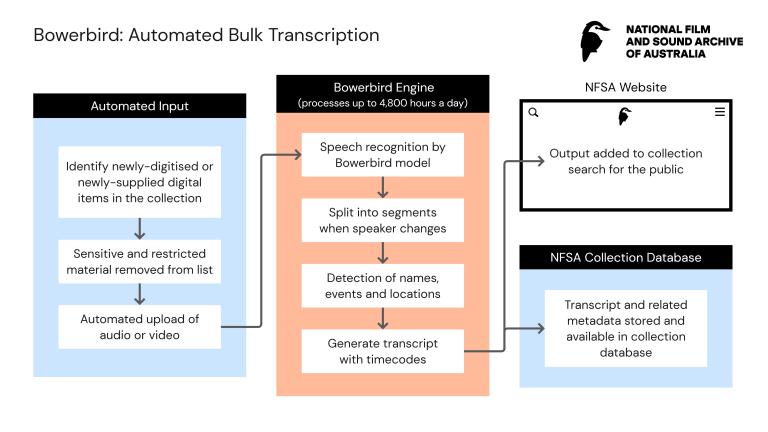Unlocking the national audiovisual collection with Bowerbird
Project summary
The National Film and Sound Archive of Australia is custodian of the national audiovisual collection ꟷ a living record of Australia’s cultural, social and creative life. The collection of radio, television, film, music, podcasts and social videos evolves with each major technological shift in audiovisual creation and experience. The collection is unknowably large, spanning the 1890s to the present.
Content volume and complexity continues to grow as digital technology enables anyone with a smartphone to become a creator. The NFSA has faced significant challenges in opening up the national collection and making content searchable and accessible. This has hindered research, industry reuse, and public engagement.
Challenges include:
- Inaccessibility: The collection contains audio and audio-visual content that was not transcribed or fully documented, making it difficult to find relevant information.
- Inaccuracy: Existing AI models generating transcription (speech-to-text) are not tailored to Australian English or Australian content.
- Resource-intensiveness: Manual transcription is time-consuming and resource-intensive. It would cost almost $10 million to manually transcribe all material in the collection.
The NFSA has conceived and developed an AI tool, called Bowerbird, to support the agency’s future as a digital-led archive. Bowerbird is a machine learning-enabled mass audio and video transcription engine. It enables staff, researchers and media industry professionals to discover and understand what is in the agency’s collection and to uncover previously hidden stories.

Bowerbird automated bulk transcription process.
Image: National Film and Sound Archive
How AI contributes to the project
In 2023, the NFSA developed a series of internal AI pilot projects, including Machine Transcription, Computer Vision and Retrial Augmented Generation. The most successful prototypes that emerged, including Bowerbird, were developed into enterprise applications in 2024 and 2025.
Bowerbird operates by understanding, transcribing, and documenting hundreds of thousands of hours’ worth of collection material, representing millions of unique stories. The engine is trained to accurately understand Australian-accented English and identify Australian places, people and objects that other technologies miss. This approach saves significantly more money and time than human or commercial automated transcription.
The NFSA used open-source, machine-learning transcription models and national language processing tools. Six open-source models were tested for performance and trainability. The chosen option was fine-tuned to recognise and reproduce Australian speech, idioms and placenames.
Outcomes and next steps
A fully searchable collection of millions of audio-visual works has created a significant positive impact for the NFSA as well as external researchers, academics and media industry users. Bowerbird is used daily by agency staff and Australian cultural partners to transcribe audio and video from their own collections.
New digital formats are increasingly networked and data-heavy, requiring specialised systems to preserve them. The NFSA is creating a database representation of all collection catalogue data, Bowerbird transcriptions and inferred entities. This will allow users to find anything in the collection, including quintessential Australian icons such as Skippy the Kangaroo, Vegemite and Kylie Minogue. It can recommend surprising connections using a system the agency is developing, called Graph Assisted Find.
In 2025ꟷ26, the NFSA will work with local technology partners to add optical character recognition and scene description to Bowerbird. This will enrich collection metadata and enable new discoveries from within the collection for staff and media industry clients, making one of Australia’s hardest working cultural collections even more valuable.
Find out more
National Film and Sound Archive of Australia (2025) Bowerbird: Unlocking the national audiovisual collection with AI, NFSA website, accessed 19 August 2025.



